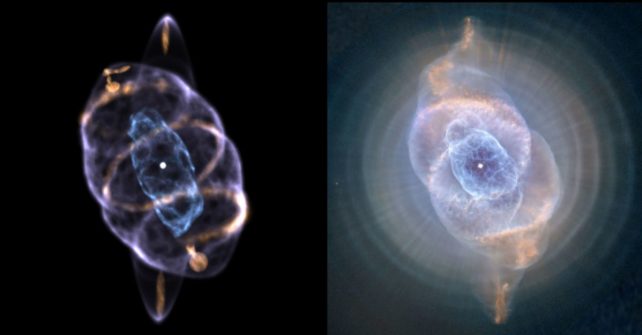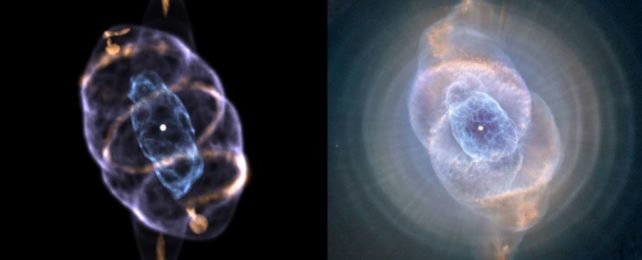The twisty eruption of a dying star has finally been revealed in all its 3D glory.
A team of scientists led by a high school graduate has reconstructed the complicated and mysterious nebulae that make up one of the most famous stellar ghosts in the sky – the Cat's Eye Nebula.
Their model revealed the mechanisms that carved out some of the previously unexplained aspects of the nebula's structure.
The results can help us understand other nebulae of this kind, and it gives us some insight into what might happen to our own Sun.
The Cat's Eye Nebula, also known as NGC 6543, is what is known as a planetary nebula. They're not related to planets at all, however; the term came about because their round shape resembles planets. Such nebulae are what's left over after a star – like the Sun – runs out of fuel to burn and reaches the end of its life.
Although planetary nebulae exhibit characteristics in common, the Cat's Eye Nebula is one of the most complex examples found to date. While it does have a round shape overall, its interior is dominated by a lozenge shape, like the pupil of a cat's eye, filled with knots, shells, and filaments.
It's one of the most studied nebulae in the sky, too, but some aspects of its structure are still a little puzzling.
They can't be easily explained under the current model of planetary nebula formation, called the interacting stellar winds model.
Under this model, the star puffs up to a red giant (like Betelgeuse) and generates a slow stellar wind that pushes stellar material into space.
Then, at the end of this stage of life, the star ejects its outer material into space, and the core, no longer supported by the outward pressure of nuclear fusion, collapses under gravity to form a white dwarf.
The very hot white dwarf generates a fast stellar wind that slams into the material in the slower wind, shocking the gas and creating shells.
The point-symmetrical, bipolar shape of the Cat's Eye Nebula doesn't fit with this model.
"When I first saw the Cat's Eye Nebula, I was astounded by its beautiful, perfectly symmetric structure," explains Ryan Clairmont, who plans to attend Stanford University. "I was even more surprised that its 3D structure was not fully understood."
So, he did something about it. He enlisted the aid of astronomers Wolfgang Steffen of the National Autonomous University of Mexico and Nico Koning from the University of Calgary in Canada and employed the use of astrophysical modeling software SHAPE to deconstruct what is going on inside the central region of the Cat's Eye Nebula.
The Hubble Space Telescope, which took incredibly detailed observations of the nebula in 2008, supplied some of the data used.
They also used spectral data from the San Pedro Martir National Observatory in Mexico, which reveal the motions of the gas inside the nebula.

The three-dimensional model they constructed revealed something interesting: spiraling rings of high-density gas, partially wrapped around the nebula's outer shell, symmetrically arranged about its two lobes.
This symmetry suggests that the rings are the result of high-speed jets ejected from the poles of the star in the center of the Cat's Eye. Because the star that produced them was wobbling like a spinning top – a motion called rotational precession – this caused the jets to come out in a spiral shape.
Their incompleteness means that the jets only erupted for a short time before being cut short.
The only thing we know of that can produce a precessing jet in a planetary nebula is a binary star. The star at the center of the Cat's Eye is thought to be a Wolf-Rayet type, not quite yet a white dwarf, but not far off, still losing mass as it burns through the very last of its fuel reserves. Such stars, when paired with another star, can create some truly spectacular nebulae.
Previous research suggested that there might be a binary companion lurking at the heart of the Cat's Eye Nebula. This new finding supports that interpretation.
Future observations and analysis will be able to take this model into account, to better interpret the strange dynamics of this fascinating nebula.
"It was very rewarding to be able to do astrophysical research of my own that actually has an impact in the field," Clairmont says.
"Precessing jets in planetary nebulae are relatively rare, so it's important to understand how they contribute to the shaping of more complex systems like the Cat's Eye. Ultimately, understanding how they form provides insight into the eventual fate of our Sun, which will itself one day become a planetary nebula."
The research has been published in the Monthly Notices of the Royal Astronomical Society.
